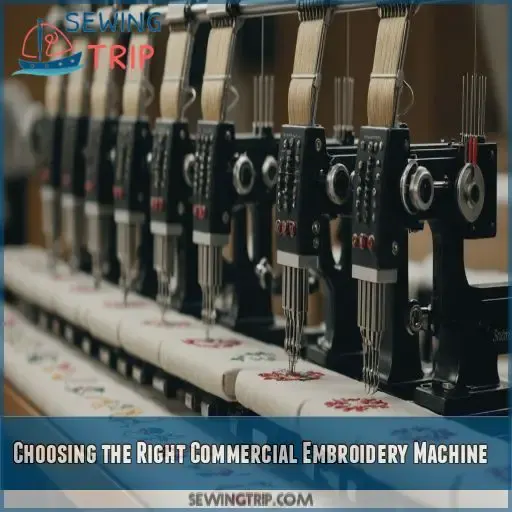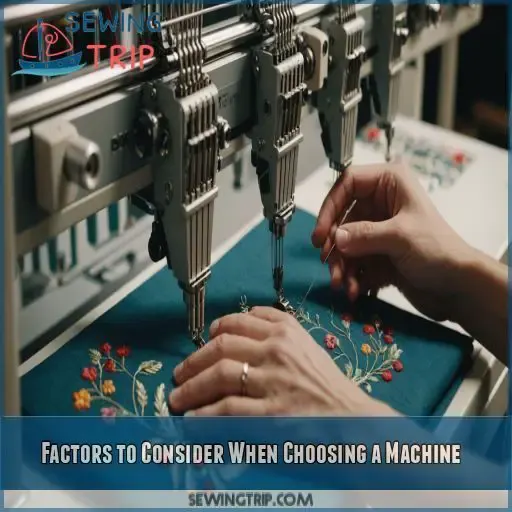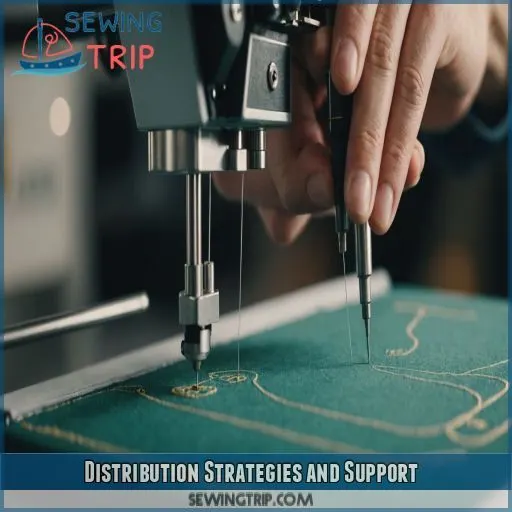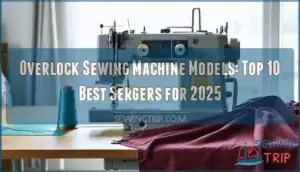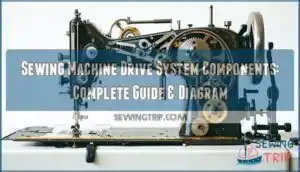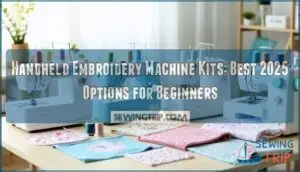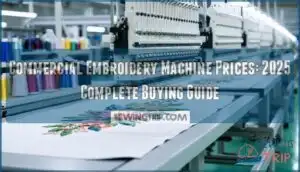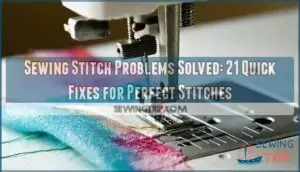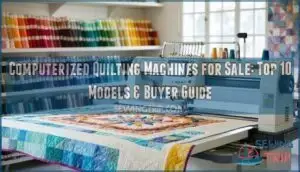This site is supported by our readers. We may earn a commission, at no cost to you, if you purchase through links.
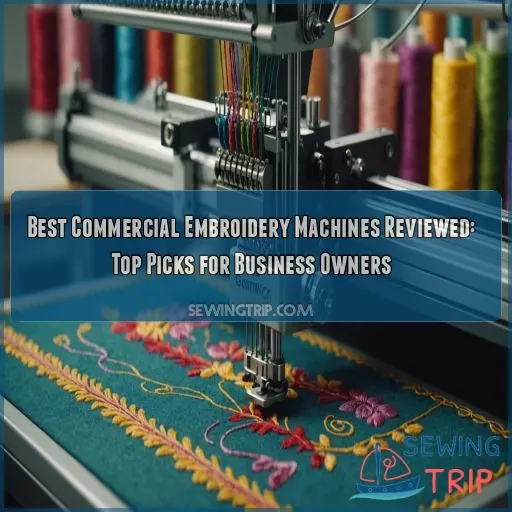 Looking for the best commercial embroidery machines reviewed? You’ve come to the right place!
Looking for the best commercial embroidery machines reviewed? You’ve come to the right place!
Whether you’re a seasoned pro or just starting your embroidery business, choosing the right machine can make or break your productivity.
Top brands like Barudan, Brother, and Melco offer powerhouses that’ll stitch circles around your old domestic machine.
Key features to watch for include needle count, embroidery area, and stitch speed – because let’s face it, time is money in this business.
Don’t forget to think about factors like built-in designs and ease of use; you don’t want to be pulling your hair out over a complicated interface.
Ready to take your embroidery game to the next level? Let’s get into the details!
Table Of Contents
Key Takeaways
- Needle count, embroidery area, and stitch speed are the holy trinity of commercial embroidery machines. The more needles, the merrier – you’ll be stitching rainbows in no time!
- Don’t put all your eggs in one basket when it comes to brands. Barudan, Brother, and Melco are the cool kids on the block, each with its own superpowers. Take them for a test drive before you commit.
- Jumping from a domestic to a commercial machine is like trading your tricycle for a Harley. Brace yourself for more needles, bigger designs, and speeds that’ll make your head spin (in a good way).
- Starting an Embroidery Business? It’s not just about the machine – you’ve got to thread the needle between market trends, pricing strategies, and legal requirements. But with the right machine as your sidekick, you’ll be stitching your way to success in no time!
Choosing the Right Commercial Embroidery Machine
You’re about to invest in a commercial embroidery machine, and you want to make sure you’re getting the right one for your business.
With so many options out there, you’ll need to think about things like the embroidery area, number of needles, stitch speed, and how easy it is to use.
You want to make sure you’re getting the best machine for your money.
Key Factors to Consider
When shopping for a commercial embroidery machine, think about your business’s specific needs. Consider the budget, desired features, and reliability. Don’t forget about maintenance costs and warranty options. Also, check the software compatibility and whether it’s user-friendly. Weigh these factors carefully to make sure you find the perfect machine for your business, giving you control, mastery, and freedom to create.
Trusted Brands for Commercial Embroidery Machines
Picking the right commercial embroidery machine can feel overwhelming, but knowing the trusted brands can make your decision a lot easier. Look for brands with solid reputations, great customer reviews, and strong warranties. Compare prices and service options to find the best fit for your business. Barudan, Brother, Happy, Melco, and Ricoma are top contenders, offering reliability and high-quality machines.
Differences Between Domestic and Commercial Embroidery Machines
Now that you’ve got a sense of the trusted brands, let’s talk about the differences between domestic and commercial embroidery machines. Here are a few key things to keep in mind:
- Needle count: Commercial machines have more needles (up to 24) for intricate designs and faster production.
- Embroidery area: Commercial machines offer larger sewing fields for bigger projects like jackets and bags.
- Stitch speed: Commercial machines are faster (up to 1,200 stitches per minute) for high-volume production.
- Automatic features: Commercial machines often have advanced thread tension, automatic thread cutting, and more.
Starting a Machine Embroidery Business
Starting a machine embroidery business? You’re on the path to creative freedom!
First, research market trends to understand your competition and target audience.
Develop a solid business plan, including a pricing strategy and marketing plan.
Don’t forget to check the legal requirements for your area.
Choose the right commercial embroidery machine, and you’ll be stitching your way to success in no time!
Factors to Consider When Choosing a Machine
When you’re shopping for the perfect commercial embroidery machine, you need to figure out the key factors that’ll make or break your business’s productivity and profitability. By thinking carefully about your needs and priorities, you can choose a machine that’s perfect for your unique demands and sets you up for success in embroidery.
Embroidery Area: Determine the Size Needed
Now that you’re choosing the right commercial embroidery machine, let’s talk about the embroidery area – the size of your canvas. Consider the types of projects you want to tackle and the designs you want to create. A larger embroidery area offers more versatility and profitability, allowing you to take on bigger, more complex projects.
Number of Needles: Consider the Number of Colors
Now that you’ve thought about the embroidery area, consider the number of needles you need. Think about your typical project’s color count and design complexity. More needles mean more colors, but also higher costs. Single-head machines usually have 6-12 needles, while multi-head machines can have up to 24. Keep in mind, more needles also increase stitch density and project scope.
Stitch Speed: Evaluate the Speed to Meet Production Needs
Your production needs are unique, so your embroidery machine’s stitch speed should match. Think of it like a highway – a faster stitch speed is like cruising in the fast lane, but only if you have the skills to handle it. Evaluate your project deadlines and efficiency goals to determine the ideal stitch speed for your business.
Built-in Designs: Check the Machine’s Design Library
When choosing a commercial embroidery machine, check the built-in designs and design library. You want a machine that can handle your creative needs. Consider:
- Design variety: Are the designs modern and relevant?
- Library size: How many designs are included?
- Update frequency: Can you access new designs regularly?
- Design quality: Are the designs high-resolution and precise?
- Licensing issues: Are you allowed to use the designs for commercial purposes?
Ease of Use: Look for User-Friendly Controls
When you’re looking for an embroidery machine, you want one that’s easy to use.
An intuitive interface that’s simple to navigate can make a big difference.
A gentle learning curve and a well-designed control panel are key.
Look for software integration and good user training.
A user-friendly machine means less frustration, more efficiency, and better results – and who doesn’t want that?
Distribution Strategies and Support
When you’re investing in a commercial embroidery machine, you need to think about more than just the machine itself.
You also need to check out the manufacturer’s distribution strategy and support.
You want to make sure you’re getting more than just a great machine – you want a partner that’s got your back with reliable support, training, and resources to help you succeed.
Sewing Center Sales: Offer Support and Community
- Local support: Get expert advice and hands-on assistance from people who understand your business needs.
- Community building: Connect with fellow embroiderers, share tips, and learn from each other’s experiences.
- Service perks: Enjoy priority service and support from your local sewing center, making maintenance a breeze.
Regional Distribution: Focus on Commercial Equipment
You’re considering regional distribution for your commercial embroidery machine purchases. Here, you’ll work with local dealers who focus on commercial equipment. They may offer more customized solutions and better support, as they understand the local market.
| Benefits | Considerations | Questions to Ask |
|---|---|---|
| Local dealer relationships | Equipment financing options | What financing options are available? |
| Regional support | Inventory availability | What’s the typical lead time for delivery? |
| Customized solutions | Commercial embroidery expertise | Can you provide training and support? |
| Access to industry events | Embroidery machine trends | How do you stay up-to-date with industry developments? |
Single Point Distribution: Direct Sales and Support
When you cut out the middleman with single point distribution, you get direct sales and support from the manufacturer – a total game-changer! You can build a strong relationship, compare prices, and tap into excellent training programs. Plus, you’ll have access to a support network and customer reviews to help you make informed decisions about your embroidery machine.
Impact: Distribution Strategy Affects Support, Training, and Pricing
Choosing the right embroidery machine is like picking a dance partner.
You want someone who’ll support you through every step and twirl of your embroidery journey.
Think about the whole package, not just where you buy it.
Local versus national support can make or break your experience.
Training options might differ, and pricing can vary too.
Frequently Asked Questions (FAQs)
What is the best brand of embroidery machines?
You’ll find great embroidery machines from brands like Tajima, Barudan, and Brother. Each offers unique strengths, so your best choice depends on your specific needs. Consider factors like speed, needle count, and embroidery area when making your decision.
Which company is best for computer embroidery machines?
You’ll find great computer embroidery machines from Tajima, Barudan, and Brother. These brands offer cutting-edge technology, user-friendly interfaces, and solid software integration. Your choice depends on your specific needs, budget, and production scale. Don’t forget to test-drive before you buy!
Is commercial embroidery profitable?
You’ve hit the jackpot! Commercial embroidery can be highly profitable. With the right machine and skills, you’ll create custom designs that clients love. It’s a craft that turns threads into gold if you play your cards right.
What is the best thread for commercial embroidery machine?
You’ll want to go for polyester thread in your commercial embroidery machine. It’s strong, colorfast, and won’t shrink or fade. Brands like Madeira, Isacord, and Robison-Anton are great choices that’ll keep your designs looking sharp.
How often should commercial embroidery machines be serviced?
Like a well-oiled machine, your commercial embroiderer needs regular TLC. You’ll want to service it every 6-8 weeks or after 500,000 stitches, whichever comes first. Keep it humming, and it’ll keep you stitching smoothly!
What are the average power consumption costs?
You’ll typically spend $5-$15 per month on electricity for a commercial embroidery machine. It’s like running a fridge – not wallet-busting, but worth factoring in. Newer models are more energy-efficient, saving you some green!
Can commercial embroidery machines handle metallic threads?
Embroidery wizards, you’re in luck! Most commercial machines can handle metallic threads like a champ. You’ll need to adjust tension and use special needles, but you’ll be stitching shimmering designs in no time. It’s a game-changer!
Are there eco-friendly options for commercial embroidery?
You’ve got eco-friendly options! Look for machines that use less energy, like LED-lit models. Consider those compatible with organic threads and water-soluble stabilizers. Some brands even offer recycling programs for old machines. It’s embroidery with a conscience!
What certifications should operators have for commercial machines?
Ever wondered what it takes to master the art of commercial embroidery? While formal certifications aren’t mandatory, you’ll want to become proficient in machine operation, design software, and safety protocols. Hands-on training and industry workshops are your best bet.
Conclusion
Imagine this: your embroidery business is running smoothly, cranking out stunning designs with ease.
That dream is within reach when you choose the right commercial embroidery machine.
We’ve covered the best commercial embroidery machines reviewed, giving you the lowdown on key features and trusted brands.
So, take the plunge, invest wisely, and watch your embroidery empire grow.
Happy stitching, and here’s to your success in commercial embroidery!

